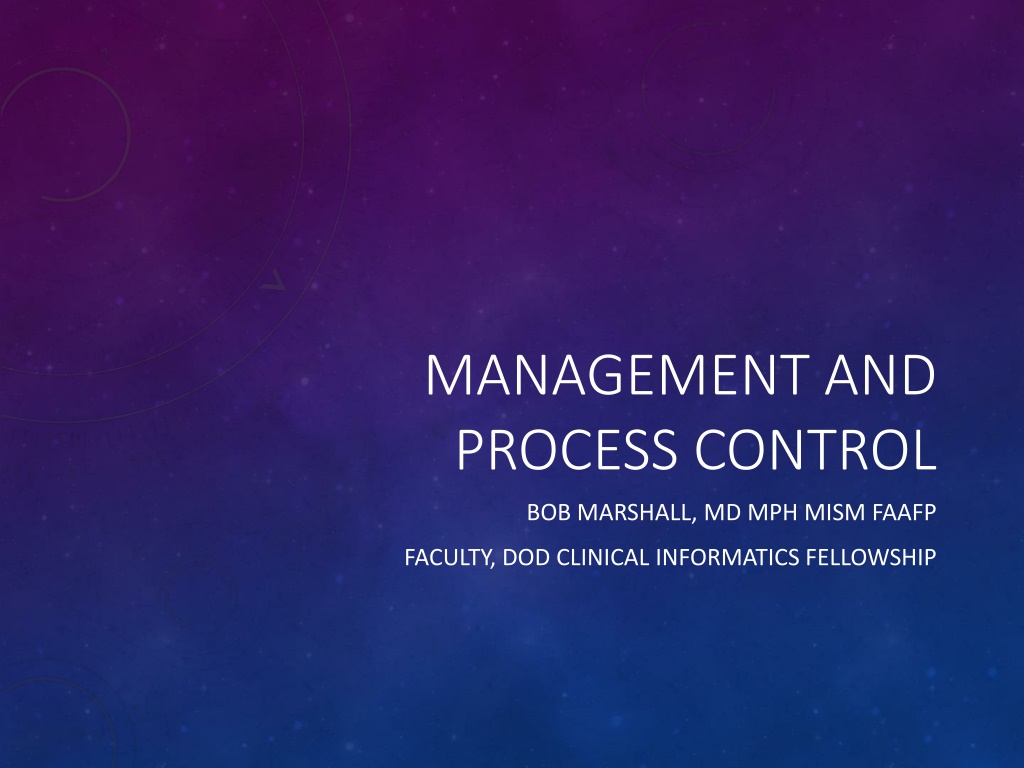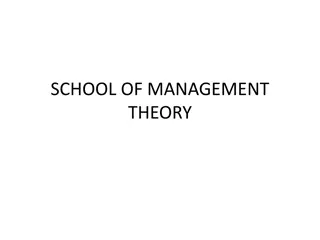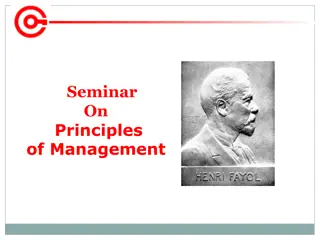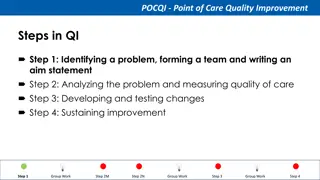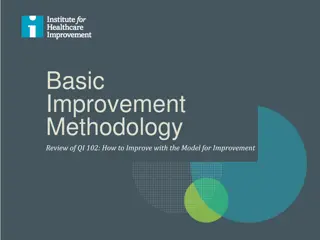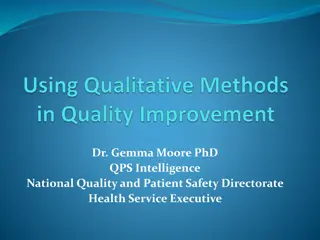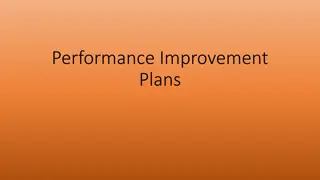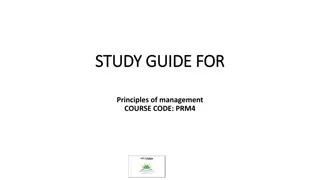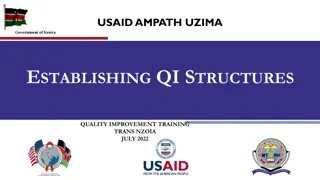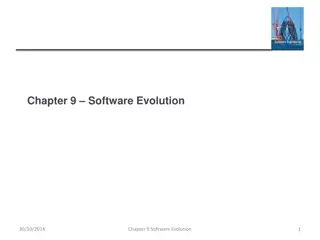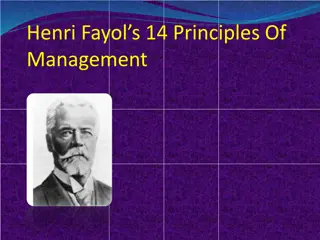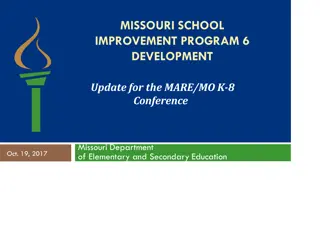Evolution of Management Principles and Process Improvement Methods
Explore the evolution of management principles from Scientific Management by Frederick Winslow Taylor to modern process improvement methodologies like Failure Effects Mode Analysis and Statistical Process Control. Uncover the critiques of Scientific Management theory and understand its impact on organizational efficiency and adaptability.
Download Presentation

Please find below an Image/Link to download the presentation.
The content on the website is provided AS IS for your information and personal use only. It may not be sold, licensed, or shared on other websites without obtaining consent from the author. Download presentation by click this link. If you encounter any issues during the download, it is possible that the publisher has removed the file from their server.
E N D
Presentation Transcript
MANAGEMENT AND PROCESS CONTROL BOB MARSHALL, MD MPH MISM FAAFP FACULTY, DOD CLINICAL INFORMATICS FELLOWSHIP
OBJECTIVES Scientific Management as a management and process improvement tool/methodology Discuss two other previously uncovered methods of Process Improvement: Failure Effects Mode Analysis Statistical Process Control
SCIENTIFIC MANAGEMENT Frederick Winslow Taylor published The Principles of Scientific Management in 1909 Proposed that productivity would increase by optimizing and simplifying jobs Advanced the idea that workers and managers needed to work together (cooperate) to be successful and efficient Believed that all workers were motivated by money; promoted idea of, a fair day s pay for a fair day s work This also meant that people who worked harder and were more efficient deserved higher pay than those who accomplished less Started the idea of time and motion studies to identify best practice
PRINCIPLES OF SCIENTIFIC MANAGEMENT 1. Replace working by rule of thumb, or simple habit and common sense, and instead use the scientific method to study work and determine the most efficient way to perform specific tasks 2. Rather than simply assign workers to just any job, match workers to their jobs based on capability and motivation, and train them to work at maximum efficiency 3. Monitor worker performance, and provide instructions and supervision to ensure that they are using the most efficient way of working 4. Allocate the work between managers and workers so that the managers spend their time planning and training, allowing the workers to perform their tasks efficiently
CRITIQUES OF SCIENTIFIC MANAGEMENT THEORY SMT promotes the idea of one right way to do things Leads to rigid, rules-driven organizations that have adaptability issues SMT breaks down tasks into tiny steps and focuses on how each person can perform his/her set of steps better/best SMT separates manual from mental work, focusing mostly on the mechanics vice the people side of work Does not address the ideas of motivation and workplace satisfaction as key elements to an efficient, productive organization SMT views labor as a commodity and leads to deskilling of jobs, making it easy to offshore the jobs
OVERVIEW OF FMEA A structured way to identify and address potential problems or failures, and their resulting effects on the system or process before an adverse event occurs Different than root cause analysis (RCA), which is a structured way to analyze and address problems after they have already occurred FMEA involves identifying and eliminating/correcting process failures in order to prevent the undesirable from occurring
WHEN TO USE FMEA When a process, product or service is being designed or redesigned. For new processes, can identify potential bottlenecks or unintended consequences prior to implementation When an existing process, product or service is being applied in a new way. Before developing control plans for a new or modified process. When improvement goals are planned for an existing process, product or service. When analyzing failures of an existing process, product or service. Periodically throughout the life of the process, product or service
BASIC FMEA TERMINOLOGY Failure mode - Specific manner or way by which a failure occurs Failure cause and/or mechanism - Defects and requirements, design, process, quality control, handling or part application which the underlying cause or sequence of causes that initiate a process failure mode Failure effect - Immediate consequences for failure on operation, function or functionality Risk Priority Number (RPN) - Severity (of the event) * Probability (of the event occurring) * Detection (probability that the event would not be detected before the user was aware of it)
MAJOR BENEFITS OF FMEA Provides documented method for selecting a design with high probability of successful operation and safety Documented, uniformed method of assessing potential failure mechanisms, failure modes and their impact on system operation Early identification of single failure points (SFPS) and system interface problems, which may be critical to mission success and/or safety Effective method for evaluating the effect of proposed changes to the design and or operational procedures on mission success and safety Basis for in-flight troubleshooting procedures and for locating performance monitoring and fault detection devices Criteria for early planning of tests
LIMITATIONS OF FMEA In the healthcare context, FM EA and other risk assessment methods have been found to have limited validity when used in isolation Challenges around scoping and organizational boundaries appear to be major factors in this lack of validity If used as a top-down tool, FMEA may only identify major failure modes in a system When used as a bottom-up tool, FMEA can augment or complement fault tree analysis and identify many more causes and failure modes resulting in top-level symptoms However, it is not able to discover complex failure modes involving multiple failures within a subsystem Multiplication of severity, occurrence and detection rankings may result and rank reversals, where a less serious failure mode receives a higher RPN than a more serious failure mode
OVERVIEW OF STATISTICAL PROCESS CONTROL A method of quality control which uses statistical methods Pioneered by Walter A. Shewart at Bell Laboratories Applied in order to monitor and control a process Monitoring and controlling the process ensures that it operates at its full potential At full potential, the process can make as much conforming product as possible with the minimum of waste Can be applied to any process where the conforming product (product meeting defined specifications) output can be measured Key tools used in SPC include: Control charts; focus on continuous improvement; and design of experiments
KEY CHARACTERISTICS AND ADVANTAGES SPC must be practiced in two phases: Initial establishment of the process Regular production use of the process A decision on the period to be examined must be determined SPC emphasizes early detection and prevention of problems vice correcting problems once they have occurred In addition to reducing waste, SPC can lead to reduced production times and reduced likelihood the product will need to be reworked
LIMITATIONS OF SPC SPC is applied to reduce/eliminate process waste This eliminates the need for the usual process step of post-manufacture inspection The success of SPC relies both on the skill with which it is applied, and also on how suitable/amenable a given process is to the application of SPC It is sometimes difficult to judge when the application of SPC is appropriate If applied to a process that is not suitable for/amenable to SPC, the outcomes will not be achieved
CONTROL CHARTS Arguably, the most successful SPC tool is the control chart (developed by Shewart) The control chart helps record data, allowing early identification of unusual events (out of alignment with the typical process) Control charts help to distinguish between two types of process variation: Common cause variation intrinsic to the process and always present Special cause variation stems from external sources, indicating the process is out of statistical control Various tests can help determine when an out-of-control event has occurred However, more tests increase the risk of false positives/alarms
NEWER BUT RELATED PROCESS MONITORING TOOLS Cumulative Sum (CUSUM) Charts: the ordinate of each plotted point represents the algebraic sum of the previous ordinate and the most recent deviations from the target Exponentially Weighted Moving Average (EWMA) Charts: each point represents the weighted average of current and all previous subgroup values Gives more weight to recent process history and decreasing weights for older data Engineering Process Control (EPC) tools: regularly change process inputs to improve performance
